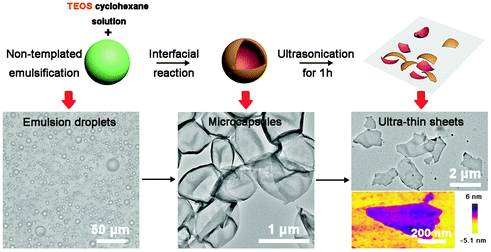Facile scalable fabrication of ultra-thin freestanding SiO2-based hybrid nanosheets with multifunctional properties
Abstract
Two-dimensional (2D) nanomaterials with unique features like a large surface-to-volume ratio and the quantum confinement effect have attracted great attention for applications in energy storage, catalysis, sensing, membranes, etc. Silica (SiO2)-based nanosheets, as members of the 2D material family, are extremely intriguing because of their unique electronic insulation, bio-compatibility and profound chemical and thermal stability. However, there is still a lack of available approaches for fabricating SiO2 nanosheets in a simple, large-scale and cost-effective fashion. In the present research, we have proposed a facile and mass fabrication method for ultra-thin freestanding SiO2-based hybrid nanosheets (SS) with a uniform thickness by crashing hollow microcapsules through ultrasonication treatment. The morphology, composition, and application of the hybrid nanosheets are investigated in detail. The experimental results demonstrate that SS nanosheets with an inorganic–organic hybrid structure display a Janus-type composition with double bonds residing on one side and hydroxyl groups on the other. Additionally, the SS nanosheets could be easily modified by introducing various functional components such as aluminium hydroxide (AH). The as-prepared SS nanosheets and AH modified nanosheets (SS-AH) could considerably enhance the thermal stability of silicone rubber with remarkably increased thermal decomposition temperatures and residues compared with the reference samples. SS and SS-AH sheets are highly superior in usage as polymer thermal stability fillers because of the following aspects: the hybrid nature of SS and SS-AH is advantageous to facilitate the filler–polymer interaction, so these particles could be readily dispersed into silicone without any hydrophobicity modification; these fillers could improve the thermal stability of elastomers at a much lower filler loading (<8%) than the previously reported filler system (e.g. >20 wt%). Furthermore, the nanosheets are also proved to be efficient in usage as emulsifiers for the immiscible oil–water system with a higher efficiency and emulsion stability than the commonly used emulsifiers. Consequently, the hybrid nanosheets fabricated in this work will not only enrich the family of ultra-thin 2D materials but also attract more interest in potential applications in functional nanocomposites and solid emulsifiers.



 Please wait while we load your content...
Please wait while we load your content...